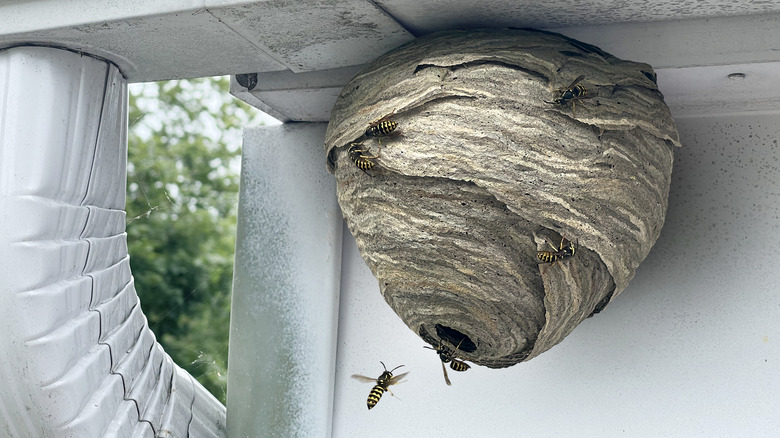Why You Should Avoid Removing A Wasp Nest
Seeing a wasp is one thing, but noticing an entire nest on your property takes it to another level — because the reality is, getting stung by any flying creature is the opposite of fun. Wasps tend to create their nests in places where they feel protected, such as in trees, under patios, or nestled in eaves. (Check out all the sneaky spots wasps build nests around the home.) If you come across one, you might muster up the courage to remove it yourself. Yet it's imperative to resist the urge and instead take alternative steps to get the job done.
A wasp nest is usually brownish-gray and constructed from a papery material. You'll likely spot a hole at the bottom of the nest, which they use to come and go. Although it may seem easy to knock it down with a broomstick, it's a move that's quite dangerous. Wasps can turn very aggressive when disturbed and have the ability to deliver powerful, painful stings.
To make matters worse, each one can sting over and over again, injecting their venom. This has the potential to be extremely serious, especially for individuals who are allergic. According to a CDC report, an average of 72 Americans died from wasp, bee, and hornet stings annually from 2011 to 2021. Overall, the unpredictability of the situation makes it far from worth the risk.
Here's what to do instead of removing the nest yourself
If you spot an active wasp's nest on your property or attached to your home, first off, remain calm so you don't agitate them. Let everyone in your household know to keep their distance from the nest, and make sure that pets aren't allowed near it either. The main goal is to avoid bothering the wasps at all costs. Call a pest professional to come in and remove the nest for you. Don't put off doing so, as the nest could grow larger and you'll remain in danger. After all, wasps are a nasty stinging pest you don't want to come into contact with. Even if you aren't allergic, being stung repeatedly could lead to a hospital trip and medical bills.
Fortunately, it's possible to take action and prevent wasps from taking over in the first place. Start by eliminating their food sources so that your residence is less ideal to them. Avoid leaving pet food outside, clean up fallen berries and fruit, and if you have a hummingbird feeder, make sure it's not right by the house. You should also fix any holes or cracks that they could use as entry points. Keep your trash cans sealed up, since rotting food and sugary items can attract them. There are also plants that help keep wasps out of your yard. But most importantly, if you do end up noticing a nest — just don't attempt to remove it yourself.

